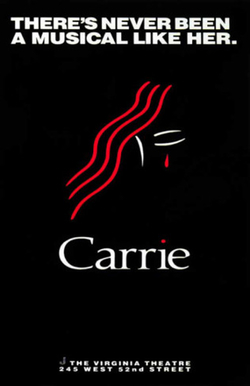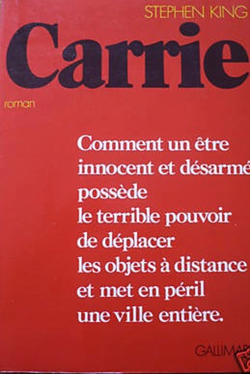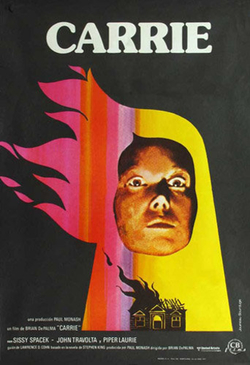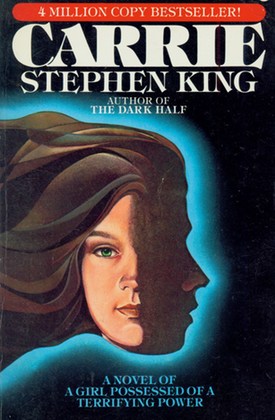People praising Stephen King sometimes chalk his popularity up to the way he tells a story. They say that he’s all about the plot, driving it ahead like a runaway train, keeping his readers hooked on the narrative until the very last page. They talk about how you just can’t put his books down, about how they kept turning pages to find out what happened next.
This is about as deep a misunderstanding of what Stephen King does as it’s possible to have. King’s priority isn’t plot, it’s character. This focus is what differentiates him from a lot of genre writers. Dan Brown and Tom Clancy don’t need no stinking characters. But Stephen King? He’s built his career out of them.
Think of Stephen King and you think of Jack Torrance, the frustrated writer going insane and trying to kill his family in The Shining, or Johnny Smith awakening from a coma missing four years of his life but with the power to see the future in The Dead Zone, or Charlie, the angry little girl with the ability to start fires with her mind in Firestarter. There’s Misery and its “Number One Fan” Annie Wilkes, or his most famous character, Carrie White of Carrie, the book that started it all. Until Dolores Claiborne came along 18 years later it would be King’s only book named after its protagonist.
Carrie was written in 1973 when King was dirt poor, living in a trailer and trying to support two kids on a high school teacher’s salary supplemented by the occasional sale of a horror story to a men’s magazine. By his own account, he was angry, depressed, and liable to drink away his paycheck if left unsupervised. Reading Carrie, you can tell.
 Bet $10 to attempt a story with a female main character by his friend, Flip Thompson, King started Carrie as a short story, but after a few pages (King has variously said four and 15) he realized that he had a novella on his hands. He reacted as most authors do to a novella: there’s no market for ‘em, so kill ‘em in the cradle before they get too big. His wife, Tabitha King, fished the first pages out of the garbage and insisted that he finish it.
Bet $10 to attempt a story with a female main character by his friend, Flip Thompson, King started Carrie as a short story, but after a few pages (King has variously said four and 15) he realized that he had a novella on his hands. He reacted as most authors do to a novella: there’s no market for ‘em, so kill ‘em in the cradle before they get too big. His wife, Tabitha King, fished the first pages out of the garbage and insisted that he finish it.
Fortunately for his financial future, the novella mutated into a novel and it sold for a $2,500 advance. The legend of Stephen King is that he was a blockbuster author right out of the gate. Not so much. Carrie sold less than 15,000 copies in hardcover. But the paperback rights were later sold for $400,000 and when it was released by New American Library as a mass market paperback one year later, it sold one million copies and changed King’s life for good.
The book itself moves in a rush (it’s King’s shortest book), beginning and ending in great big gushes of menstrual blood (Carrie does for menstruation what Portnoy’s Complaint had done for masturbation six years earlier). These days, Stephen King is famous for two things: writing horror books, and writing very, very long books. And while the dreamy images from Brian De Palma’s film adaptation have largely colonized my memory of Carrie (as have memories of Carrie the musical, which I unfortunately saw – don’t feel too bad, you’re not missing anything) it was a surprise to re-read the book and see how fuel-efficient it actually is.
 It’s this simple: Carrie White is a frugly teenager with a domineering, Bible-thumping, sex-hating mother and latent psychic powers. Her first period hits in the locker room showers and she doesn’t know what it is. Her classmates surround her, pelt her with tampons, and chant, “Plug it up! Plug it up!” As an act of atonement for participating in Carrie’s bullying, nice girl Sue Snell asks her boyfriend, Tommy, to take Carrie to the Spring Dance. As an act of revenge after being punished for bullying Carrie, mean girl Chris Hargensen plans to douse Carrie with pig’s blood at the Spring Dance. She’s assisted by her greaser boyfriend, Billy Nolan.
It’s this simple: Carrie White is a frugly teenager with a domineering, Bible-thumping, sex-hating mother and latent psychic powers. Her first period hits in the locker room showers and she doesn’t know what it is. Her classmates surround her, pelt her with tampons, and chant, “Plug it up! Plug it up!” As an act of atonement for participating in Carrie’s bullying, nice girl Sue Snell asks her boyfriend, Tommy, to take Carrie to the Spring Dance. As an act of revenge after being punished for bullying Carrie, mean girl Chris Hargensen plans to douse Carrie with pig’s blood at the Spring Dance. She’s assisted by her greaser boyfriend, Billy Nolan.
Everything in the book pretty much springs from Carrie’s first period: Sue’s guilt, Chris’s revenge plot, and the awakening of Carrie’s telekinetic powers. The night of the Spring Dance arrives, Carrie masters her telekinesis, stands up to her crazy mom, gets crowned homecoming queen, and has pig’s blood dumped on her in front of everyone. She freaks out and kills the entire town with her brain, finally bleeding to death from a knife wound inflicted by her Bible-thumping momma.
Compared to later books by King, Carrie is so short that it’s practically a haiku, but most of his stylistic trademarks are already present:
Quotations – Stephen King loves quoting poetry and song lyrics, and while Carrie features far fewer quotes than his later books (probably because the clearances department wasn’t willing to do too much heavy lifting for a then-unknown author) he still manages to get in fragments of Bob Dylan’s “Tombstone Blues” and “Just Like a Woman.”
Stream of Consciousness – Nothing says “Stephen King” like italicized stream of consciousness sentence fragments and run-on sentences that suddenly explode out of the middle of a paragraph. After some parenthetical asides in the beginning of Carrie, we get to page 20 and:
She looked back
(old bitch hates my momma)
over her shoulder.
It’s the first time he uses this device, but it’s certainly not the last. In the future, he’ll use it to the point of self-parody.
Multiple POVs – Not only is Carrie split between the points-of-view of Chris Hargensen, Sue Snell, Carrie White, her gym teacher, and her mother, but it’s also split between straight narrative, transcripts of hearings, excerpts from academic papers, eyewitness interviews, police reports, hospital admissions records, newspaper articles, and excerpts from Sue Snell’s fictitious memoir. It’s practically a collage novel. In later books, King will hopscotch around from one character’s skull to another, and he’ll often use a newspaper story or an excerpt from a magazine article to add some reality, but never again does he do it quite so much as he does in Carrie.
There’s also plenty of clumsy writing on display. In the opening shower scene, the girls are described as having “light and eager” morning sweat, whatever that is. Their gym teacher is described as being “their slim, nonbreasted gym teacher” which is a weird way to say she has small breasts. Throughout the book people make unreproducible sounds like “Ohuh” and when Carrie’s skirt rips at one point, it does so with “the sound of a huge wind-breakage.” Oh, you mean a fart? Even King isn’t a big fan. “I’m the first to admit that it is often clumsy and artless,” he said in a 1983 interview about Carrie. In another interview he praises De Palma’s film, claiming that the book is “too sobersided” and impeded by “a certain heaviness” whereas De Palma’s movie made it “frothy.”
 So why’d Carrie catch on? It hit shelves in 1974, a time when there was a fascination with teenagers that was not being served by popular culture. It was the year that the over-sexed teen jiggle comedy, The Cheerleaders, became an unexpected hit, and it’s easy to see why when you contrast it to what else was on movie screens. The majority of books and movies about teenagers hearkened back to a 1950’s pre-JFK-assassination era world of greasers and bobby soxers. American Grafitti and Lords of Flatbush were big hits (Billy Nolan, Chris’s boyfriend in Carrie, feels like a throwback to these 50’s greasers – ironically, he’d be played by the ultimate greaser throwback, John Travolta, in the film). The few movies that depicted contemporary teenagers were movies like 1969’s The Last Summer and 1971’s The Last Picture Show which were nihilistic, dead-end films that made underaged sex feel as cold and dour as sawing wood.
So why’d Carrie catch on? It hit shelves in 1974, a time when there was a fascination with teenagers that was not being served by popular culture. It was the year that the over-sexed teen jiggle comedy, The Cheerleaders, became an unexpected hit, and it’s easy to see why when you contrast it to what else was on movie screens. The majority of books and movies about teenagers hearkened back to a 1950’s pre-JFK-assassination era world of greasers and bobby soxers. American Grafitti and Lords of Flatbush were big hits (Billy Nolan, Chris’s boyfriend in Carrie, feels like a throwback to these 50’s greasers – ironically, he’d be played by the ultimate greaser throwback, John Travolta, in the film). The few movies that depicted contemporary teenagers were movies like 1969’s The Last Summer and 1971’s The Last Picture Show which were nihilistic, dead-end films that made underaged sex feel as cold and dour as sawing wood.
There was nothing dour about Carrie. It kicked off with a show stopper setpiece in the girl’s locker room, a voyeuristic, unforgettable scene that anticipated Porky’s by four years, and the sex just kept on coming. The first 50 pages alone featured endless of talk of “upthrust” teenaged breasts, Sue Snell making it with Tommy in his car (twice), one teenaged orgasm, Carrie massaging her own breasts in her bedroom almost to the point of masturbation, and topless teenaged sunbathing. To round it all off, King threw in a couple of bright green snot bubbles, a drunk with an enormous goiter on his neck, and lots of icky talk of bacne, pimples, and blackheads.
This was not what the readers of 1974 were used to finding in their books. Popular fiction in 1973 and ‘74 was a sawdust-flavored mixture of sober, high-minded doorstops by James Michener and Gore Vidal, leavened with glossy sex and sin bestsellers by Jacqueline Susann and Harold Robbins, with the occasional historical novel thrown in for fun. Science fiction was all hard SF novels of ideas like Arthur C. Clarke’s Rendezvous with Rama and Ursula K. Le Guin’s The Dispossessed. Horror fiction, however, did have a pulse, having received a recent infusion of respectability with the one-two-three of Rosemary’s Baby (1967), The Exorcist (1971), and Thomas Tryon’s double act of The Other (1971) and Harvest Home (1973).
But those books had pretensions to respectability. There was nothing respectable about Carrie, nothing high-minded. It wasn’t about upper middle class New Yorkers with good educations and nice clothes. It was raw, racy, and set firmly in a blue collar community. Full of tampons, religious mania, glow-in-the-dark Jesus paintings, boogers, teenaged boobs, and lots and lots of death, no one had read anything like it. As rough and raunchy as moonshine, it came slouching out of the wrong part of town, threw readers up against the bathroom stall, and yanked down their pants, offering a head-spinning mix of seedy thrills and tight, character-focused writing.
But King wasn’t just a character-writer, he had another narrative trick up his sleeve: he knew how to make the reader wait. And, as Wilkie Collins said, the recipe for a good book is “Make ‘em laugh, make ‘em cry, make ‘em wait.” From the first page of Carrie we know something really bad is going to happen at the Spring Dance because King reminds the reader on every other page that Something Really Bad Is Going to Happen at the Spring Dance. The more it’s hinted at, the more you want to see it, but King’s a showman, and he knows how to milk a moment.
 Right at the climax, the moment the book is building towards, King abandons Carrie’s point-of-view. We’re in her head right up until she gets crowned Queen, and then the pig’s blood comes down, and then…we get Billy and Chris Hargensen’s POV from outside the gym, we get a scene of Sue Snell making cocoa back home and hearing fire engines, we get an excerpt from a Reader’s Digest article about the prom night disaster, then Tommy’s POV as the falling bucket of blood knocks him unconscious and everything goes black, then wire items from the AP about the disaster, another Sue Snell scene as she races to the burning school, a transcript from an inquest about the prom night disaster, and only after all this do we rewind backwards and finally get released into Carrie’s head for the big pay-off.
Right at the climax, the moment the book is building towards, King abandons Carrie’s point-of-view. We’re in her head right up until she gets crowned Queen, and then the pig’s blood comes down, and then…we get Billy and Chris Hargensen’s POV from outside the gym, we get a scene of Sue Snell making cocoa back home and hearing fire engines, we get an excerpt from a Reader’s Digest article about the prom night disaster, then Tommy’s POV as the falling bucket of blood knocks him unconscious and everything goes black, then wire items from the AP about the disaster, another Sue Snell scene as she races to the burning school, a transcript from an inquest about the prom night disaster, and only after all this do we rewind backwards and finally get released into Carrie’s head for the big pay-off.
And it’s Carrie’s point-of-view that makes the book. Based on two actual students of his, King’s Carrie White is an example of character-based writing in motion. Carrie starts off seen from the outside, a big, dumb, ugly, zit-covered dork who’s so stupid she deserves to be humiliated. Then King gets inside her head and becomes deeply sympathetic to her plight, offering her a chance to reclaim her dignity. He’s ambivalent about her: he hates her (and probably his former students) for being weak, but he also wants to see them beat the bullies. But in real life the good guys don’t always win and just when all Carrie’s dreams seem to be coming true, hope is cruelly snatched away.
This is where King shifts gears and truly steers his book into Horrorville. When Carrie uses her telekinesis to fight back, her word choice, rhythm, and diction transform into those of her hated mother, the most gothic and horrific character in the book. For the entire book she’s fought against her mother, resisting her influence, but when Carrie’s mind snaps you see her morph into her mother right there in the paragraph break. The characters aren’t aware of what’s happened, but it’s all too obvious to the reader: Carrie has turned into the woman she hates more than anyone in the world. And so Carrie dies with her most horrifying fear coming true: she grows up to be just like momma.
Grady Hendrix has written about pop culture for rags ranging from Playboy to World Literature Today. He also writes books! You can follow every little move he makes over at his blog.










